Feeling Tired, Weak, or Unmotivated? It Might Be Your Testosterone Levels.
Testosterone isn’t just about libido or muscle gains—it’s the hormone that fuels masculinity. It powers your energy, mental clarity, drive, strength, and confidence. But here’s the problem: after the age of 30, your testosterone levels can drop by 1% each year. That means less stamina, more fat, and slower results in the gym.
But here’s the good news—you can fight back naturally. The right exercises can fire up your body’s natural testosterone production like rocket fuel. In this post, we’re diving into 10 killer exercises scientifically shown to help men elevate their testosterone levels without pills or gimmicks. These aren’t your average curls and crunches—these are results-driven movements.
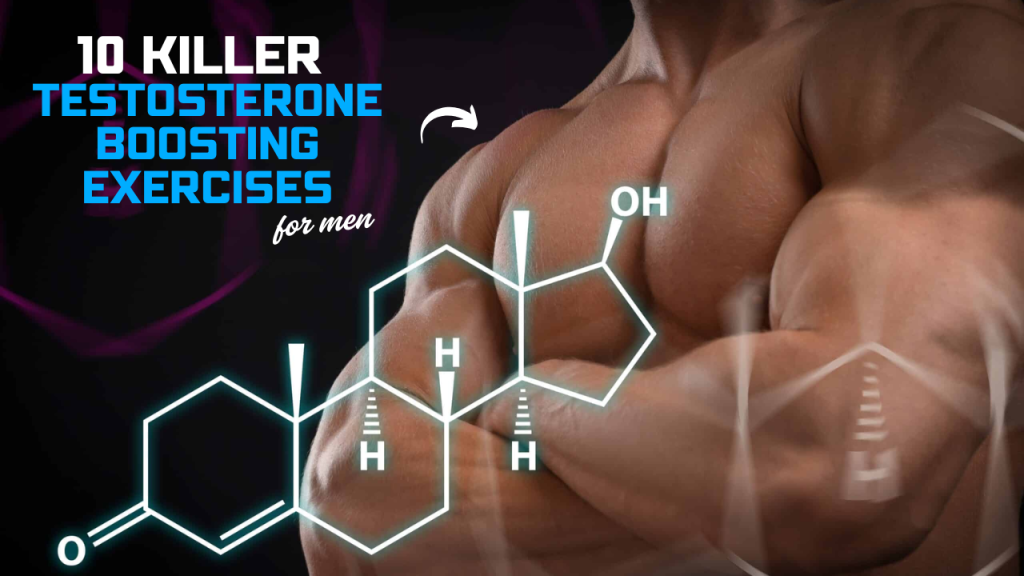
Table of Contents
Do’s and Don’ts for Boosting Testosterone Through Exercise
| Do’s | Don’ts |
|---|---|
| Focus on compound lifts like squats, deadlifts, and bench press | Avoid only doing isolation exercises (like bicep curls) |
| Include HIIT for short, intense cardio bursts | Don’t overdo long-duration cardio (e.g. excessive running) |
| Train 3–5 days a week with rest days | Don’t train every day without recovery—overtraining lowers testosterone |
| Lift heavy with progressive overload | Don’t stick with light weights and high reps forever |
| Eat enough healthy fats (avocados, nuts, eggs) | Don’t follow low-fat or extremely restrictive diets |
| Sleep 7–8 hours consistently | Don’t sacrifice sleep for late-night workouts or screen time |
| Manage stress with breathing, meditation, or light activity | Don’t let chronic stress or high cortisol levels go unchecked |
| Stay hydrated and support workouts with proper nutrition | Don’t rely on supplements or energy drinks alone |
| Use proper form and warm-up before heavy lifts | Don’t rush into workouts without prepping your body |
| Track progress and adjust workouts every few weeks | Don’t keep repeating the same routine for months |
What Can Happen After 30 Days of Testosterone-Boosting Exercise
| Positive Changes | Description |
|---|---|
| Increased Energy Levels | More consistent stamina and less fatigue throughout the day |
| Improved Mood | Reduced anxiety, depression, and mood swings due to hormonal balance |
| Enhanced Libido | Boosted sex drive and performance thanks to increased testosterone |
| Noticeable Muscle Gain | Better muscle tone and strength, especially in upper and lower body |
| Fat Loss | Reduced body fat—especially around the belly—due to improved metabolism |
| Better Sleep Quality | Deeper, more restorative sleep as hormone levels stabilize |
| Higher Confidence | A sense of mental clarity, focus, and physical confidence |
| Improved Recovery Time | Faster muscle recovery between workouts |
| More Discipline & Routine | Enhanced motivation, discipline, and structure in daily life |
| Slight Testosterone Increase | Measurable improvement in natural testosterone production for most men |
Why Testosterone Matters for Men
Before we hit the gym floor, let’s quickly understand why testosterone is crucial:
- Builds lean muscle and burns fat
- Improves mood and reduces anxiety
- Enhances focus and memory
- Boosts libido and sexual performance
- Supports cardiovascular health
Low testosterone = low performance—in every area of life.
10 Best Testosterone Boosting Exercises
1. Squats – The King of Testosterone Boosters

Squats aren’t just for your legs—they activate the largest muscle groups, triggering massive hormone release. Compound lifts like squats tell your body: “We need more power!”
Why it works: Activates glutes, quads, hamstrings, and core. Stimulates growth hormone and testosterone production.
How to:
- Stand with feet shoulder-width apart.
- Place barbell on your upper traps.
- Lower down into a squat until thighs are parallel to the ground.
- Push through your heels to return to the top.
- Tips:
- Keep your chest up and core tight.
- Avoid letting knees cave inward.
- Reps/Sets: 3–4 sets of 6–10 reps, 2–3x per week.
Pro tip: Go heavy (5–8 reps) with proper form. Barbell back squats work best.
2. Deadlifts – Full-Body Power Surge
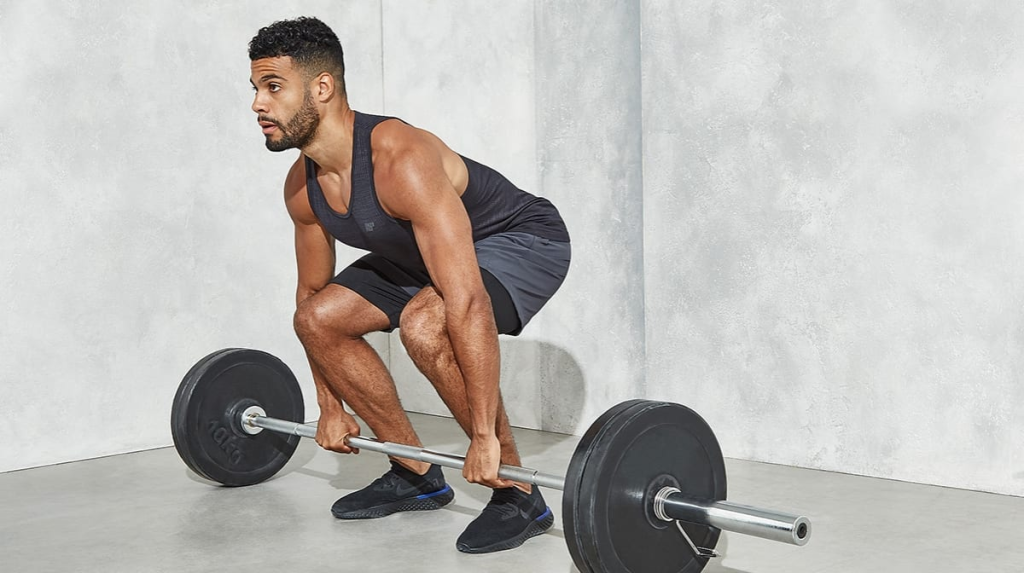
Deadlifts are the ultimate testosterone shock. It’s raw power—grip, rip, and feel the surge.
Why it works: Engages your posterior chain (hamstrings, glutes, back), boosting full-body strength and hormonal output.
How to:
- Stand with feet hip-width apart, barbell over mid-foot.
- Bend at hips and knees, grip the bar.
- Keep back straight, pull the bar up by extending hips and knees.
- Lower under control.
Tips:
- Engage core, avoid rounding back.
Reps/Sets: 3 sets of 5–8 reps, 1–2x per week.
Variation: Try Romanian or trap-bar deadlifts to mix it up.
3. Bench Press – Push for Hormonal Gains
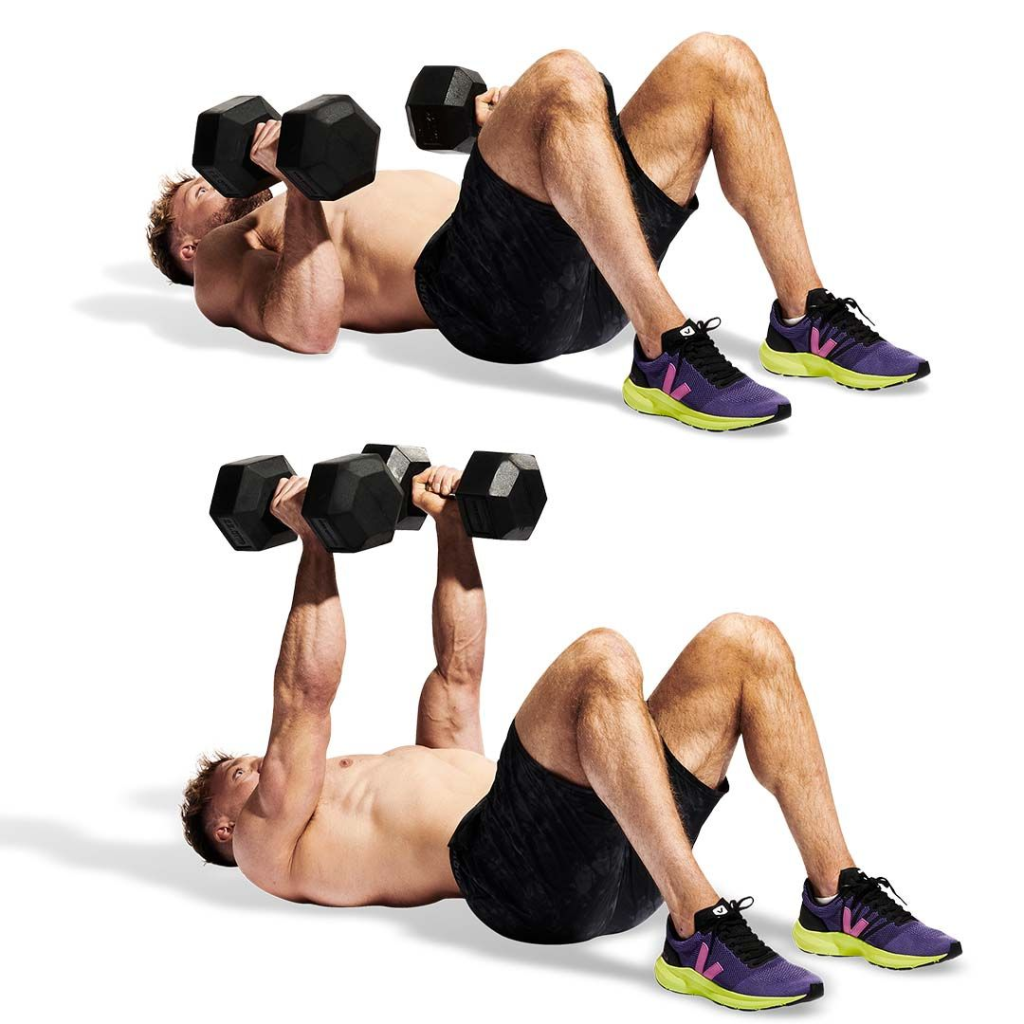
The bench press isn’t just about a bigger chest—it’s a testosterone-friendly move if done right.
Why it works: Uses large upper-body muscles like pecs, delts, and triceps, especially under heavy resistance.
How to:
- Lie flat on a bench, grip bar just wider than shoulder width.
- Lower bar to mid-chest, press upward until arms are straight.
Tips:
- Keep feet flat and shoulder blades pinched together.
Reps/Sets: 3–4 sets of 6–10 reps, 2x per week.
Tip: Focus on compound pressing rather than machines. Go for 4 sets of 6–8 reps.
4. High-Intensity Interval Training (HIIT)
If long-distance running is burning you out, switch to HIIT. It burns fat without tanking your testosterone.
Why it works: Short bursts of intense effort (like sprinting) followed by rest can raise testosterone and growth hormone.
How to:
- Sprint at 90–100% effort for 20–30 seconds.
- Walk or rest for 1–2 minutes.
- Repeat for 5–8 rounds.
Tips:
- Warm up well before sprinting to avoid injury.
Sessions: 2–3x per week.
Example HIIT workout: 30 seconds sprint / 90 seconds walk — repeat for 15–20 minutes.
5. Pull-Ups – Simple, But Savage

Pull-ups require no fancy gear and target key upper-body muscles.
Why it works: Activates the lats, biceps, shoulders, and core. Builds upper-body strength, triggers anabolic hormone response.
How to:
- Grab a pull-up bar with overhand grip.
- Pull yourself up until chin clears the bar.
- Lower slowly to starting position.
Tips:
- Avoid swinging or using momentum.
Reps/Sets: 3 sets of max reps, 3x per week.
Challenge yourself: Use a weighted vest or increase reps over time.
6. Sled Pushes & Farmer’s Carries

These “strongman” moves mimic real-world strength—and your testosterone levels will love them.
Why it works: Full-body activation, metabolic stress, and heavy load-bearing combine to release more testosterone.
Farmer’s carry tip: Go heavy, walk 20-30 meters, repeat for 3–4 rounds.
7. Olympic Lifts (Clean & Jerk, Snatch)
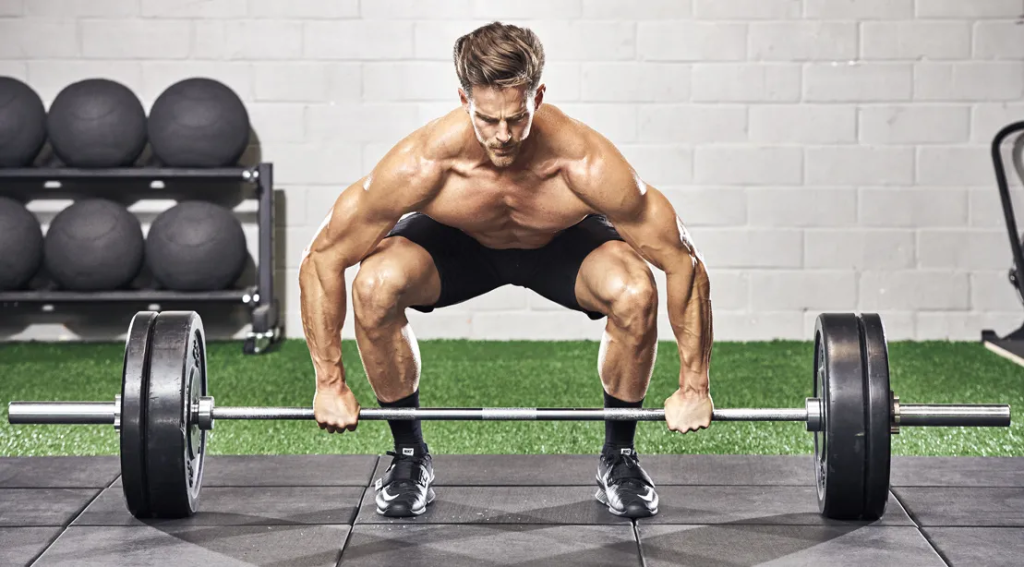
These explosive lifts are highly technical—but they unlock explosive hormonal responses.
Why it works: Total-body, high-intensity power moves. They improve neuromuscular coordination, speed, and hormone output.
Note: Learn proper form with a coach to avoid injury.
8. Weighted Lunges

Lunges don’t just tone your legs—they challenge your balance, coordination, and stability.
Why it works: Engages multiple muscles, especially when done with dumbbells or a barbell. High muscle engagement = high T-response.
How to:
- Step forward, lowering until both knees are at 90 degrees.
- Push back to standing and repeat on the other leg.
Tips:
- Keep your torso upright and knee behind toes.
Reps/Sets: 3 sets of 10 reps per leg, 2–3x per week.
Add a twist: Try walking lunges for added difficulty and core activation.
9. Overhead Press – Total Upper-Body Activation

Lifting weight overhead demands strength from shoulders, triceps, core, and even legs.
Why it works: Pushes your body into anabolic overdrive when done with proper load and form.
How to:
- Stand with barbell at shoulder level.
- Press bar upward until arms are fully extended.
- Lower slowly to shoulders.
Tips:
- Keep core tight and avoid arching back.
Reps/Sets: 3–4 sets of 6–8 reps, 2x per week.
Tip: Stand instead of sitting—it activates more muscle groups and improves posture.
10. Kettlebell Swings – Explosive and Efficient
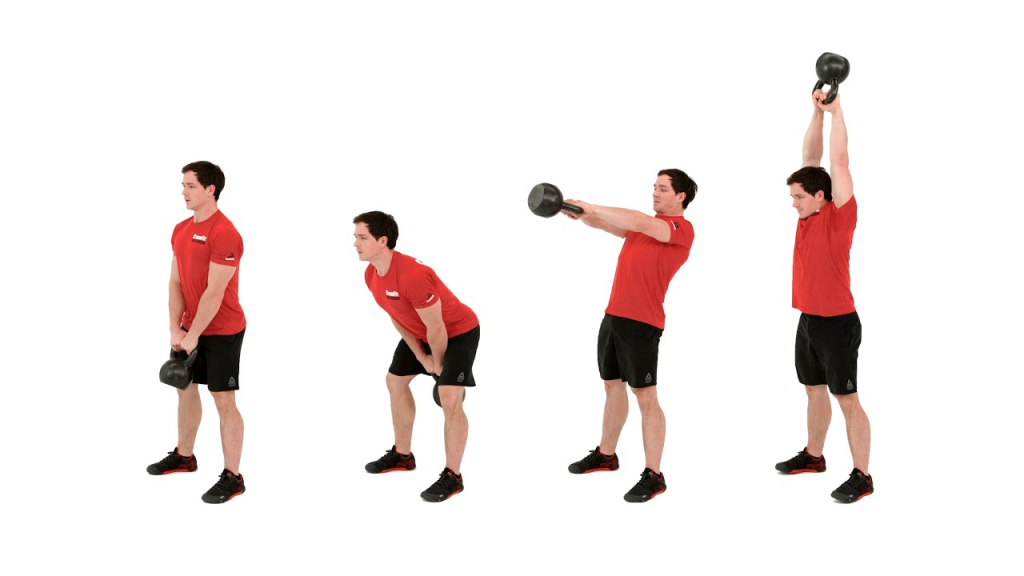
Don’t underestimate the kettlebell. Swings build posterior strength and cardio endurance in one punch.
Why it works: Explosive hip thrusts trigger hormonal release, improve circulation, and enhance fat burn.
How to:
- Hinge at hips, swing kettlebell back and then drive forward to shoulder height.
Tips:
- Use hips, not arms; keep spine neutral.
Reps/Sets: 3 sets of 15–20 reps, 2–3x per week.
Bonus: Great for men over 40 due to low joint impact and high return.
Quick Testosterone-Boosting Exercise Protocol
Here’s a sample weekly split combining these exercises:
| Day | Workout |
|---|---|
| Monday | Heavy Squats + Pull-Ups + Core |
| Tuesday | HIIT (Sprints or Bike) |
| Wednesday | Rest or Active Recovery |
| Thursday | Deadlifts + Overhead Press |
| Friday | Farmer’s Carries + Kettlebell Swings |
| Saturday | Clean & Jerk + Bench Press |
| Sunday | Rest or Yoga/Stretching |
Extra Tips to Maximize Testosterone Gains
- Eat enough healthy fats (avocados, eggs, olive oil)
- Get 7–8 hours of sleep – testosterone production peaks during REM
- Reduce stress – high cortisol crushes T-levels
- Avoid alcohol and processed sugar
- Supplement with vitamin D, zinc, and magnesium if needed
Final Thoughts: Work Smarter, Not Just Harder
You don’t need fancy machines or endless cardio. Just compound, heavy, intense training mixed with smart recovery. These 10 testosterone-boosting exercises aren’t magic, but when done consistently, they unlock real strength, vitality, and confidence.
Ready to reclaim your edge? Hit the gym with purpose. Your testosterone (and future self) will thank you.
Frequently Asked Questions (FAQs)
Can exercise really increase testosterone naturally?
Yes. Compound and high-intensity exercises—like squats, deadlifts, and HIIT—have been shown to boost testosterone by stimulating muscle growth, reducing fat, and improving overall hormonal balance.
How often should I work out to boost testosterone?
Aim for 3–5 days a week of resistance or HIIT training. Overtraining can reduce testosterone, so be sure to include rest days for recovery and optimal hormone production.
Which type of exercise is best for testosterone: weightlifting or cardio?
Weightlifting—especially compound lifts—is the most effective. Short bursts of cardio like HIIT can help, but chronic long-distance cardio (like marathon training) may actually lower testosterone over time.
How long does it take to see results in testosterone levels from exercise?
Most men start to notice changes in 4 to 6 weeks with consistent training, good nutrition, and proper sleep. Hormonal improvements often reflected in mood, energy, libido, and strength.
Are bodyweight exercises effective for boosting testosterone?
Yes—especially moves like pull-ups, push-ups, and dips. While they might not match heavy weightlifting in hormone impact, progressive overload, and consistency still stimulate testosterone production.
Does sleep affect testosterone levels?
Absolutely. Testosterone levels can drop significantly with poor sleep. Aim for 7–8 hours of quality sleep per night—testosterone is mainly released during deep REM sleep cycles.
Can I combine testosterone-boosting exercises with fat loss goals?
Yes. In fact, testosterone helps preserve muscle mass while burning fat. Combine strength training, HIIT, and a clean diet to support both T-levels and weight loss.
Do supplements help increase testosterone too?
Some supplements like vitamin D, zinc, magnesium, and ashwagandha may support testosterone production—but they work best when paired with proper exercise, diet, and sleep.
Are these exercises safe for men over 40 or 50?
Yes, but focus on form, joint health, and proper recovery. Men over 40 benefit greatly from strength training—but should consult a trainer or healthcare provider before starting a new routine.





